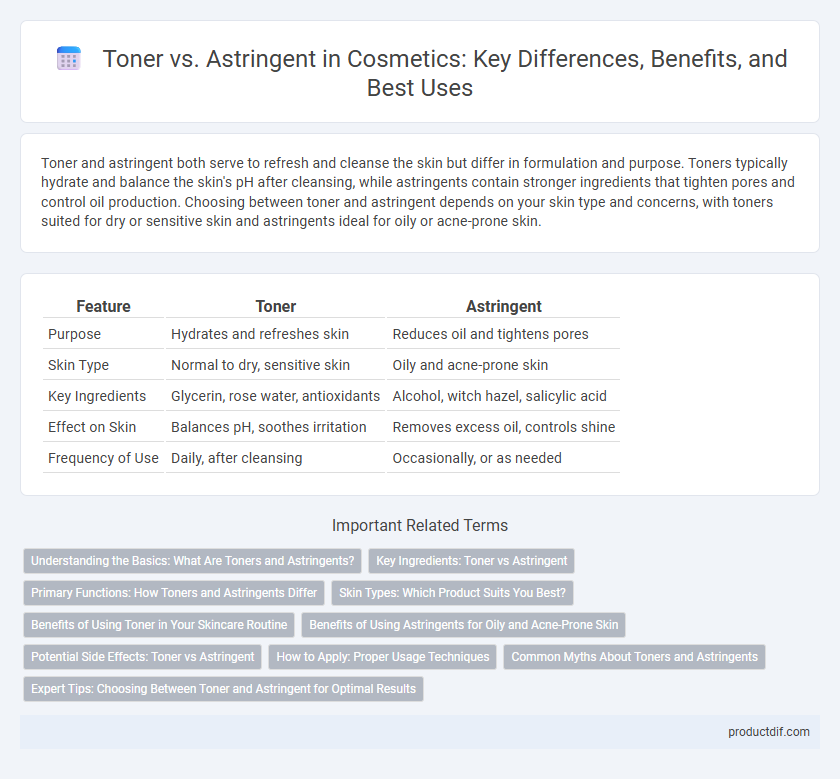Toner and astringent both serve to refresh and cleanse the skin but differ in formulation and purpose. Toners typically hydrate and balance the skin's pH after cleansing, while astringents contain stronger ingredients that tighten pores and control oil production. Choosing between toner and astringent depends on your skin type and concerns, with toners suited for dry or sensitive skin and astringents ideal for oily or acne-prone skin.
Table of Comparison
| Feature | Toner | Astringent |
|---|---|---|
| Purpose | Hydrates and refreshes skin | Reduces oil and tightens pores |
| Skin Type | Normal to dry, sensitive skin | Oily and acne-prone skin |
| Key Ingredients | Glycerin, rose water, antioxidants | Alcohol, witch hazel, salicylic acid |
| Effect on Skin | Balances pH, soothes irritation | Removes excess oil, controls shine |
| Frequency of Use | Daily, after cleansing | Occasionally, or as needed |
Understanding the Basics: What Are Toners and Astringents?
Toners are lightweight liquids designed to hydrate, balance pH levels, and remove residual impurities after cleansing, while astringents primarily focus on tightening pores and controlling excess oil, often containing higher concentrations of alcohol. Both products help refine skin texture but serve different skin types: toners suit dry or sensitive skin, whereas astringents are ideal for oily or acne-prone skin. Effective skincare routines choose formulations based on these functional differences to enhance overall skin health.
Key Ingredients: Toner vs Astringent
Toners typically contain soothing ingredients like witch hazel, rose water, and glycerin that balance skin pH and hydrate without stripping moisture. Astringents often include stronger, alcohol-based components such as salicylic acid and benzoyl peroxide, which tighten pores and reduce excess oil for oily or acne-prone skin. Choosing between toner and astringent depends on skin type, with toners favoring hydration and astringents targeting oil control and pore minimization.
Primary Functions: How Toners and Astringents Differ
Toners primarily balance skin pH and provide hydration, replenishing moisture after cleansing, while astringents focus on tightening pores and reducing excess oil to minimize shine. Toners are typically gentler, suitable for normal to dry skin, whereas astringents contain more potent ingredients like alcohol, targeting oily and acne-prone skin. Both serve to prepare the skin for subsequent skincare steps but differ significantly in formulation and effect.
Skin Types: Which Product Suits You Best?
Toners are typically suited for sensitive and dry skin as they help restore pH balance and provide hydration without stripping moisture. Astringents contain stronger ingredients like alcohol and are ideal for oily or acne-prone skin, effectively reducing excess oil and tightening pores. Choosing between toner and astringent depends on your skin type, with toners offering gentle care and astringents delivering more intensive oil control.
Benefits of Using Toner in Your Skincare Routine
Toner helps balance the skin's pH, minimize pores, and remove residual impurities after cleansing, promoting a clearer complexion. It provides essential hydration and prepares the skin to absorb serums and moisturizers more effectively. Regular use of toner can enhance skin texture, reduce inflammation, and support overall skin health.
Benefits of Using Astringents for Oily and Acne-Prone Skin
Astringents help minimize the appearance of pores and control excess oil production, making them ideal for oily and acne-prone skin. Their antiseptic properties reduce inflammation and prevent bacterial growth, aiding in the prevention of acne breakouts. Common astringent ingredients like witch hazel and salicylic acid provide targeted cleansing without over-drying the skin.
Potential Side Effects: Toner vs Astringent
Toners often contain gentle hydrating ingredients with minimal risk of irritation, while astringents typically include alcohol or witch hazel, which can cause dryness, redness, and sensitivity, especially for sensitive skin types. Overuse of astringents may disrupt the skin's natural barrier, leading to increased irritation and potential flare-ups of conditions like eczema or rosacea. Choosing a product aligned with your skin type and monitoring for adverse reactions is essential to avoid these potential side effects.
How to Apply: Proper Usage Techniques
Apply toner using a cotton pad or fingertips, gently patting it onto cleansed skin to balance pH and refresh without stripping moisture. For astringents, dab sparingly on oily or acne-prone areas to minimize pores and control excess sebum, avoiding sensitive or dry skin to prevent irritation. Consistent use after cleansing ensures optimal absorption and enhances skin texture.
Common Myths About Toners and Astringents
Toners and astringents are often misunderstood, with common myths suggesting toners strip the skin while astringents are only for oily skin types. Toners can actually hydrate and balance the skin's pH, while astringents contain stronger ingredients like alcohol to reduce oil and tighten pores. Choosing the right product depends on skin type and concerns, not on the misconception that one is harsher or less beneficial than the other.
Expert Tips: Choosing Between Toner and Astringent for Optimal Results
Experts recommend selecting toner or astringent based on skin type: toners, enriched with hydrating ingredients like glycerin or hyaluronic acid, restore pH balance and soothe sensitive skin, while astringents containing alcohol or witch hazel effectively reduce oiliness and tighten pores for oily or acne-prone skin. For optimal results, applying toner after cleansing maintains moisture without stripping natural oils, whereas astringents should be used sparingly to prevent irritation. Understanding the specific formula and your skin's needs ensures the best outcome in your skincare routine.
Toner vs Astringent Infographic

 productdif.com
productdif.com